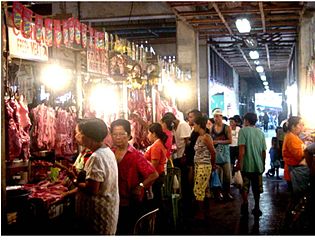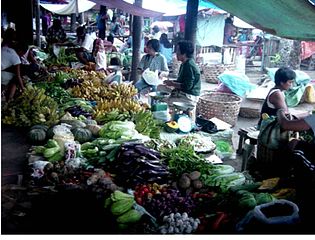



A palengke is a public market common in the Philippines. It is where the Filipino masses shop for their needs, especially food.
The word palengke came from the Spanish word palenque, which literally means a palisade or stockade, a wall. During the Spanish colonization, the word was used to describe a pathway or a cluster of tables set up at a gathering of indios such as a theater, tournament, or a market. Eventually, the Spaniards' rule ended and the context for palenque, now palengke, refers to the, you guessed it, the market.
Nowadays, a palengke is usually composed of several dozen stalls sharing a common roof. The Filipinos have embraced the palengke as part of their culture. Everyday, someone in the family (commonly the mom or the eldest child) would go to the palengke to buy some meat, vegetables and rice. If there's some money left after buying what is needed, they may buy some toys, sampaguita, and other items they want to bring on the way back home.
Though the palengke has long been part of Filipino culture, it is criticized as being unsanitary, obsolete, and hindering modernization, which is why the palengke is often connected to poverty. Recently, it is being challenged by the more commericalized supermarkets and shopping malls and centers. Supporters of the palengke argue that it can't be removed from Filipino culture, and that the palengke instilled a sense of community which the more "modern" alternatives can't replicate. In my opinion, as long as poverty and conservatism remains, the concept of palengke will not be obsolete, and it will live on for more generations to come. Parte na yan ng buhay.